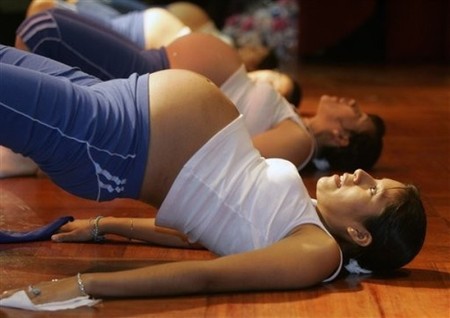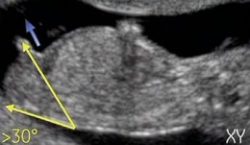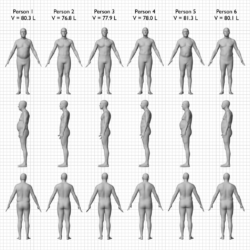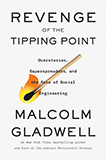“Don’t forget to do your kegels!” is one mantra that every pregnant woman hears.
However, just how effective are kegel exercises?
As much as fellow moms and moms-to-be tell me how beneficial they are, I have heard and read many accounts of women who have regularly done kegels throughout their pregnancies only to suffer from horrible incontinence after birth.
I also know of women who have never done kegels and continue to have perfect post-partum urinary control.

image source
Yesterday, I read that kegels may not always prevent incontinence. In fact, a biomedical scientist named Katy Bowman believes that doing too many kegels may cause pelvic floor disorder (which leads to incontinence)! Instead, Bowman recommends exercises such as squats to help strengthen the pelvic floor.
Click on over to Mama Sweat for the full interview with Katy Bowman, and be sure to check out the follow-up interview too.
While I won’t go on ahead to immediately dismiss the recommendations of highly-respected medical sources such as the Mayo Clinic and the American Academy of Pediatrics, I can’t help but wonder if Bowman’s claims have a ring of truth. After all, the pubococcygeus muscles (which kegels aim to strengthen) alone cannot attribute to urinary control. Wouldn’t the gluts and other core muscles also help prevent pelvic floor dysfunction?
A quick search on PubMed shows a review paper titled “Pelvic floor exercises during and after pregnancy: a systematic review of their role in preventing pelvic floor dysfunction” which states:
RESULTS: Antepartum PFEs, when used with biofeedback and taught by trained health care personnel, using a conservative model, does not result in significant short-term (3 months) decrease in postpartum urinary incontinence, or pelvic floor strength. Postpartum PFEs, when performed with a vaginal device providing resistance or feedback, appear to decrease postpartum urinary incontinence and to increase strength. Reminder and motivational systems to perform “Kegel” exercises are ineffective in preventing postpartum urinary incontinence. Postpartum PFEs do not consistently reduce the incidence of anal incontinence.
According to this paper, kegels are not helpful when done before delivery; only when done after, and only when you have something physical to squeeze.
Based on these findings, I’m inclined to believe that while kegels during pregnancy may be beneficial, they will not aid in post-partum incontinence unless combined with pelvic floor exercises. In addition, I should continue to do kegels after giving birth to help my body get back into its pre-pregnancy shape.
Can any moms chime in? Do you think kegels helped you in preventing urinary incontinence post-delivery?






 I like books, gadgets, spicy food, and art. I dislike shopping, hot weather, and the laws of entropy. Although I am a self-proclaimed computer nerd, I still have a love for handbags and makeup... and I am always teetering on high heels. To learn more about me, visit the
I like books, gadgets, spicy food, and art. I dislike shopping, hot weather, and the laws of entropy. Although I am a self-proclaimed computer nerd, I still have a love for handbags and makeup... and I am always teetering on high heels. To learn more about me, visit the 


I read this! You always here though, do kegels, do kegels!
hmm hmm hmm
incontinence was a minor issue during pregnancy (when i sneezed or walked really fast). i think i did kegels maybe twice during my pregnancy…not to deal with incontinence, but i heard that it helps building up some muscles that help during delivery. never did them afterwards. everything works appropriately.
still pregnant with about 2-3 weeks left. never did kegels. was just too lazy. only peed when I sneezed with a full bladder. Otherwise, empty bladder, gets no pee.
I never peed my pants… pre or post pregnancy. Ever. In fact, I was really sad when my water broke because I thought I had peed my pants and really didn’t think it was my water breaking.
I have really good bladder control though… and I have a feeling that has much more to do with it.
I never really did Kegels, and I have no issues. I saw this article on some of the birth blogs I read, and I haven’t seen any evidence to discredit Bowman’s claims. However, I did see a lot of comments (and, I have no evidence to back this) that a lot of women do Kegels incorrectly. Every time I’ve heard anyone say to do Kegels while you pee, a ton of other people come in and say that you should *only* do that the first time to figure out which muscles to flex, and that regularly stopping the flow like that can cause incontinence issues. I don’t know if women doing the exercise correctly were included in the findings that Kegels alone don’t help.
Sorry, I generally don’t like to just pass along second-hand information without having the facts to back it up, but all I know is what I’ve heard people say.
How ironic that the illustration photo shows Kegels not done correctly, or rather> not Kegels at all.
You can\t see any body part move at all if Kegel is done right.
@Ste — Sorry for being lazy and just grabbing one of the first images of pregnant women exercising I can find. But like you said, if you're doing kegels correctly others can't notice. So what do you propose instead? An anatomical diagram?
Hmm it looks like your site ate my first comment (it was extremely long) so I guess I’ll just sum it up what I submitted and say, I’m thoroughly
enjoying your blog. I too am an aspiring blog blogger but I’m still new to the whole thing. Do you have any suggestions for rookie blog writers? I’d certainly
appreciate it.